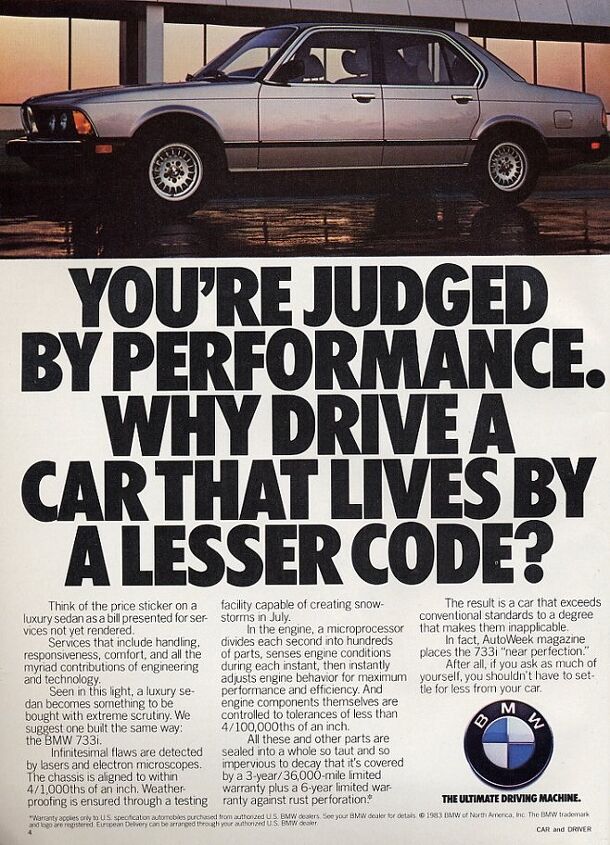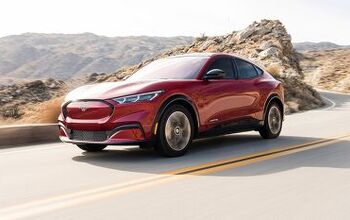Capsule Review: 1984 BMW 733i (5-Speed)

In the highly unlikely event that my father precedes me into the grave, I will have to come up with another way to describe him besides “the late Kevin Baruth”. The old man’s never been late for something in his life. Nor has he even been a terribly, shall we say, easy-going fellow. One of the medals he received in Vietnam was, if I recall correctly, for single-handedly halting the retreat of a disorganized Marine unit after the death of said unit’s commander and forcing them to turn around and advance towards the enemy. I have no trouble imagining how this might have happened; I’d rather shoot it out with a company of NVA regulars than contradict my father.
I mention all of the above for a reason. When I tell my friends that I learned how to drive in a black 1984 BMW 733i, they say, “That’s pretty cool.” When I explain further that it was the relatively rare manual-transmission variant, they say, “That’s even cooler.” It’s difficult to make them understand that it’s tough to learn how to drive in a stick-shift car, tougher to do it in a $36,000 ($77K in today’s money) BMW, and worse yet to do it with someone sitting next to you who might, just possibly, rip your head off at any moment.
How shall we describe the “E23” 733i? One way to describe it would be like so: in terms of size, weight, power, and transmission choice, it’s about the same as a 2011 Honda Accord EX four-cylinder. Here’s another: like every full-sized BMW since from the “New Six” to the modern 750Li, it was an alternative but inferior choice to the S-Class Mercedes, at a considerably reduced price: $36,000 compared to the $51,200 MSRP of the 1984 500SEL. That was back in the days when you paid more, and received more, for the three-pointed star. W126 Benzos are perfectly capable of traveling a million miles or more in their service lives. By contrast, most E23 Bimmers were sag-assed buy-here-pay-here fodder by the time they clocked 75k. They were disposable garbage and that’s one of the few traditions BMW continues to respect with the 7 Series until this very day.
Not that it wasn’t a joy to drive, particularly once I figured out how to operate a clutch and roll it up to highway speeds. Back in 1987, the year I turned sixteen, the average car on the street was a four-cylinder Chevrolet Celebrity, Plymouth Reliant, or Nissan Stanza. Compared to them, the 181-horsepower BMW was a rocketship with a burnished leather interior and fascinating red-lit gauges. The shifter was long-throw but it was effortless to negotiate, the brakes were powerful without being grabby, and the engine simply radiated competence and character. Derek Kriendler’s notes about the acceleration of affluence apply here as well; in 1987 a “Siebener” BMW was still a relatively rare and prestigious sight. As a teenager I felt like Someone driving it.
How did it handle? In a pair of words, not well. The aforementioned 2011 Accord EX would have no trouble showing it a clean rear bumper in a back-road battle. Not to worry, because racetrack prowess was besides the point. The purpose of the car was to rocket along the ‘bahn at an easy 130mph, sweeping the Golfs and Astras out of your path with a set of staggered-size quad halogen-beam headlamps. Sadly, we didn’t get those here due to US regulations and had to make do instead with the normal DOT-legal small round quads. One feature that BMW would have been smart to leave in Europe: the ridiculous Michelin TRX metric wheels and tires. Many a BMW owner, including my father, discovered to their sorrow that tires for the 390mm BMW TRX wheels were difficult to find and insanely expensive when you could find them.
The US-spec E23s also suffered from big, ungainly impact bumpers that completely trivialized the “shark nose” profile shared with its far more iconic 633i sibling. Nor were we permitted to have the 745i, which wasn’t a 4.5L at all but simply a turbo 3.2 six. Perhaps the best E23 was the South African exclusive “M7” normally-aspirated 745i which replaced the turbo twelve-valver with the fabulous 24-valve six also found in the M6 and M5.
This was the era when BMW had driver-angled center stacks, and I’m embarrassed to admit that I was very impressed by this as a child. Back then, most cars still had wide, flat dashboards. Hell, the Porsche 911 didn’t even have a full console back then, but the BMW 733i certainly did. It was cool, and it seemed special at the time. BMW might do well to re-differentiate itself from the competition by reintroducing the angled center stack.
BMW’s relentless efforts to revise history have painted the mid-Eighties as a seamless part of the company’s inexorable rise to prominence, but at the time the Munich men seemed a little adrift. The 3-Series was at its all-time low point (the eight-valve 318i), the Five was stuck with the 127-horsepower “eta” low-rev six, and the Seven was the car you see above, a distant also-ran to the almighty W126. The products weren’t compelling, the marketing was ridiculously faux-upscale, and the Acura Legend was about to debut and make the mid-size Germans seem a bit over-priced and under-specified. It wasn’t a foregone conclusion at all that BMW would succeed, really.
Faced with this dismal situation, the company started working on quick-fixes. The 325e showed that the 528e’s lackluster six could shine in a smaller car, while the 533i and succeeding 535i pulled the same trick on a bigger, faster scale. A slightly de-powered 256-horsepower variant of the M1 six-cylinder found a home in the M5 and M6, and BMW won the race to put a twelve-cylinder in a German luxury car with the E32 750il. It was all uphill from there.
If the 733i failed to make a terribly lasting impression on the market, it certainly made one on my father. He drove a succession of black BMWs over the years to come, interrupted by the occasional Jaguar or Infiniti, before returning to BMW for his current 528i. I was annoyed that he didn’t buy a 550i or at least a 535i, but he points out that it has more features than the old 733i, costs less in current money, and is a little bit faster. “Fast enough to get me to the airport on time” he notes. Not that I would expect him to ever arrive late.

More by Jack Baruth
Latest Car Reviews
Read moreLatest Product Reviews
Read moreRecent Comments
- Brian Uchida Laguna Seca, corkscrew, (drying track off in rental car prior to Superbike test session), at speed - turn 9 big Willow Springs racing a motorcycle,- at greater speed (but riding shotgun) - The Carrousel at Sears Point in a 1981 PA9 Osella 2 litre FIA racer with Eddie Lawson at the wheel! (apologies for not being brief!)
- Mister It wasn't helped any by the horrible fuel economy for what it was... something like 22mpg city, iirc.
- Lorenzo I shop for all-season tires that have good wet and dry pavement grip and use them year-round. Nothing works on black ice, and I stopped driving in snow long ago - I'll wait until the streets and highways are plowed, when all-seasons are good enough. After all, I don't live in Canada or deep in the snow zone.
- FormerFF I’m in Atlanta. The summers go on in April and come off in October. I have a Cayman that stays on summer tires year round and gets driven on winter days when the temperature gets above 45 F and it’s dry, which is usually at least once a week.
- Kwik_Shift_Pro4X I've never driven anything that would justify having summer tires.



































Comments
Join the conversation
LOL, this reminds me of my experience learning how to drive, down to the "never mistake for easy-going" Vietnam veteran father.
Twice this damn site has said I was logged in but when I went to post, it would tell me I had to be logged in to post. And when I open a story from an email link, I am told I have to log in, but when I do, I either have to plow through the wordpress admin page to the TTAC homepage and then hunt for the story, or I have to back arrow my browser. But when I do the latter, I am in a logged out state again, unless I refresh the tab. Why can't you just log in and then be taken right back to the article you logged in from? There are more gyrations necessary than in a Rube Goldberg invention, or than Mr. Peepers had to go through to get his locker open. There is a lot I love about this site, but the mechanics of its commenting system isn't one of them. Now to my point. Wasn't it the 750il that earned an article in an ancient R&T about how the car was a combinatorial explosion of different ways to configure its valet key, or something like that. While it doesn't take to many choices for too many options to get above a thousand, as I recall, they came up with a calculation that there was a five or six digit number of ways to configure valet options, and they claimed that this proved that automobile complexity, at least in the BMW, had jumped the shark, though I don't think they used that term. The article was a really good one. I would like to see it resurrected and made available to modern readers.